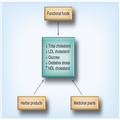Abstract
Although synthetic chemicals and pharmacological agents are being used for the treatment of cardiovascular disease in the western world, there now appears to be a cultural and philosophical shift toward Eastern Medicine and many patients are increasingly using alternative approaches for prevention and therapeutic purposes. This brief review summarizes the experimental and clinical evidence of some functional foods, herbal products and medicinal plants for improving plasma HDL cholesterol, LDL cholesterol, triglycerides and glucose levels, as well as reducing oxidative stress. In addition, the potential of acupuncture and Yogic meditation are discussed as emerging approaches for reducing cardiovascular disease risk factors. The available evidence indicates that several functional foods, herbal products and medicinal plants exert lipid-lowering and hypoglycemic actions, as well as exhibit antioxidant properties; however, a great deal of research work and extensive clinical trials are needed to establish their use in medical practice.
Introduction
The accumulation of lipids within arteries remains the initial stimulus for the pathogenesis of atherosclerosis; however, oxidative stress is also considered to play a critical role in this process.[1]Several lipid-lowering drugs, such as statins, are used as the first-line therapy in hypercholesterolemia.[2]Statin monotherapy is generally well tolerated; however, a low frequency occurrence of myopathy and asymptomatic increase in hepatic transaminases have been reported.[2] In addition, since statins are prescribed on a long-term basis, drug–drug interactions are possible, since many of the patients that receive statins may also be prescribed other medications for concomitant conditions.[2] In a study on cholesterol-lowering statin drugs (all types) involving 150,000 postmenopausal women, aged 50–79, it was found that statin intake was linked to a 48% increase in the risk of developing diabetes.[3]Furthermore, statin use was linked to an even higher risk of diabetes in Hispanic and Asian women, at 57 and 78% higher, respectively, and women who were not overweight (and thus not at risk of developing diabetes) were at a similar risk as women who were overweight for developing diabetes. Interestingly, it has been suggested that while statins are of benefit for people with known heart disease, they may be of no benefit to individuals without known heart disease and are attempting to control their blood cholesterol levels.[4]
On the other hand, the use of herbal and medicinal plant products has gained popularity as preventive or therapeutic agents for cardiovascular disease (CVD). Herbs are generally defined as any form of plant or plant products that are regarded as food or natural health products. Herbal supplements have been used for medicinal purposes for thousands of years in the East, particularly the Ayurvedic system and the Chinese medicine, and have recently become popular among consumers in the west.[5] It should be mentioned that Ayurveda is derived from two Sanskrit words, namely 'Ayus' and 'Veda,' meaning life and knowledge, respectively. It is a holistic system that focuses on the body, mind and conscious. Ayurvedic treatment consists of the use of herbal preparations and emphasizes the practice of yoga and meditation.[6] The traditional Chinese medicine is based on 'Zheng' system for the control of overall function of the human body and emphasizes the use of acupuncture and that practice of qigong.[7] Herbal medicines including traditional Chinese and Ayurvedic medicines are considered to be cost-effective in the management of disease and this alternative form of medical practice differs in philosophy from the modern medicine, and is known to play an important role in health maintenance.[8]
In the holistic approach to health care, both the disease and the underlying causes are being controlled through physical, mental, social and spiritual well-being. Although these alternative therapies are gaining popularity, several issues regarding safety and efficacy of herbal medicines remain to be addressed.[5,9,10] Since elevated levels of plasma total cholesterol, LDL cholesterol (LDL-C), triglycerides (TGs) and glucose are well-known risk factors for coronary artery disease (CAD), this brief review is focused on some of the alternative therapies for improving blood lipid profile and glucose levels. While it has been argued that it is not only native LDL that contributes to atherosclerosis, but the amount of oxidized LDL that is a key contributor to atherosclerosis,[1] this article will therefore also discuss the possible antioxidants effects of functional foods, herbal products and medicinal plants. In view of the role of diabetes as a major risk factor for CVD, this article will also discuss the hypoglycemic and hypolipidemic effects of these therapies during diabetes.
The selected therapies are based on the availability of clinical evidence on efficacy, with respect to improvements in the plasma profiles of total cholesterol, HDL cholesterol (HDL-C), LDL-C (native and oxidized forms) and TGs, as well as glucose-lowering and antioxidant effects (Figure 1). These natural products deserve further work to isolate and characterize their constituents for the development of novel and more effective agents. A consideration for acupuncture, as well as yoga, is also presented as emerging alternative approaches in preventing/treating CVD.
